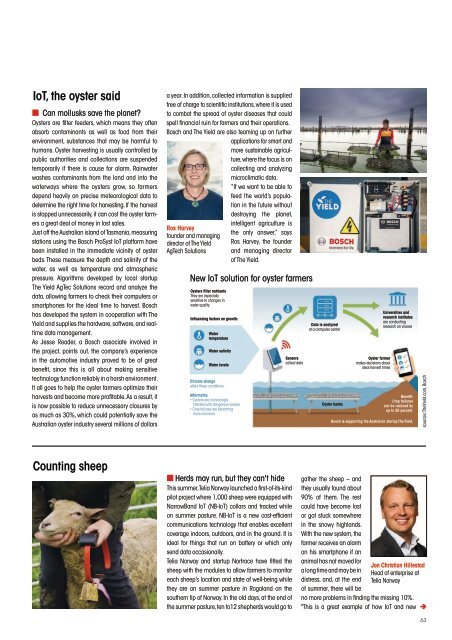Smart Industry 1/2018
Smart Industry 1/2018 - The IoT Business Magazine - powered by Avnet Silica
Smart Industry 1/2018 - The IoT Business Magazine - powered by Avnet Silica
Create successful ePaper yourself
Turn your PDF publications into a flip-book with our unique Google optimized e-Paper software.
IoT, the oyster said<br />
■ Can mollusks save the planet?<br />
Oysters are filter feeders, which means they often<br />
absorb contaminants as well as food from their<br />
environment, substances that may be harmful to<br />
humans. Oyster harvesting is usually controlled by<br />
public authorities and collections are suspended<br />
temporarily if there is cause for alarm. Rainwater<br />
washes contaminants from the land and into the<br />
waterways where the oysters grow, so farmers<br />
depend heavily on precise meteorological data to<br />
determine the right time for harvesting. If the harvest<br />
is stopped unnecessarily, it can cost the oyster farmers<br />
a great deal of money in lost sales.<br />
Just off the Australian island of Tasmania, measuring<br />
stations using the Bosch ProSyst IoT platform have<br />
been installed in the immediate vicinity of oyster<br />
beds. These measure the depth and salinity of the<br />
water, as well as temperature and atmospheric<br />
pressure. Algorithms developed by local startup<br />
The Yield AgTec Solutions record and analyze the<br />
data, allowing farmers to check their computers or<br />
smartphones for the ideal time to harvest. Bosch<br />
has developed the system in cooperation with The<br />
Yield and supplies the hardware, software, and realtime<br />
data management.<br />
As Jesse Reader, a Bosch associate involved in<br />
the project, points out, the company’s experience<br />
in the automotive industry proved to be of great<br />
benefit, since this is all about making sensitive<br />
technology function reliably in a harsh environment.<br />
It all goes to help the oyster farmers optimize their<br />
harvests and become more profitable. As a result, it<br />
is now possible to reduce unnecessary closures by<br />
as much as 30%, which could potentially save the<br />
Australian oyster industry several millions of dollars<br />
a year. In addition, collected information is supplied<br />
free of charge to scientific institutions, where it is used<br />
to combat the spread of oyster diseases that could<br />
spell financial ruin for farmers and their operations.<br />
Bosch and The Yield are also teaming up on further<br />
applications for smart and<br />
more sustainable agriculture,<br />
where the focus is on<br />
collecting and analyzing<br />
microclimatic data.<br />
“If we want to be able to<br />
feed the world’s population<br />
in the future without<br />
destroying the planet,<br />
Ros Harvey<br />
founder and managing<br />
director of The Yield<br />
AgTech Solutions<br />
intelligent agriculture is<br />
the only answer,” says<br />
Ros Harvey, the founder<br />
and managing director<br />
of The Yield.<br />
New IoT solution for oyster farmers<br />
Oysters filter nutrients<br />
They are especially<br />
sensitive to changes in<br />
water quality.<br />
Influencing factors on growth:<br />
Water<br />
temperature<br />
Water salinity<br />
Water levels<br />
Climate change<br />
alters these conditions.<br />
Aftermaths:<br />
• Oysters are increasingly<br />
infected with dangerous viruses<br />
• Crop failures are becoming<br />
more common<br />
Sensors<br />
collect data<br />
Data is analyzed<br />
at a computer center<br />
Oyster banks<br />
Oyster farmer<br />
makes decisions about<br />
ideal harvest times<br />
Universities and<br />
research institutes<br />
are conducting<br />
research on viruses<br />
Benefit:<br />
Crop failures<br />
can be reduced by<br />
up to 30 percent.<br />
Bosch is supporting the Australian startup The Yield.<br />
sources: TheYield.com, Bosch<br />
Counting sheep<br />
■ Herds may run, but they can't hide<br />
This summer, Telia Norway launched a first-of-its-kind<br />
pilot project where 1,000 sheep were equipped with<br />
NarrowBand IoT (NB-IoT) collars and tracked while<br />
on summer pasture. NB-IoT is a new cost-efficient<br />
communications technology that enables excellent<br />
coverage indoors, outdoors, and in the ground. It is<br />
ideal for things that run on battery or which only<br />
send data occasionally.<br />
Telia Norway and startup Nortrace have fitted the<br />
sheep with the modules to allow farmers to monitor<br />
each sheep’s location and state of well-being while<br />
they are on summer pasture in Rogaland on the<br />
southern tip of Norway. In the old days, at the end of<br />
the summer pasture, ten to12 shepherds would go to<br />
gather the sheep – and<br />
they usually found about<br />
90% of them. The rest<br />
could have become lost<br />
or got stuck somewhere<br />
in the snowy highlands.<br />
With the new system, the<br />
farmer receives an alarm<br />
on his smartphone if an<br />
animal has not moved for<br />
a long time and may be in<br />
distress, and, at the end<br />
of summer, there will be<br />
Jon Christian Hillestad<br />
Head of enterprise at<br />
Telia Norway<br />
no more problems in finding the missing 10%.<br />
"This is a great example of how IoT and new<br />
63
















